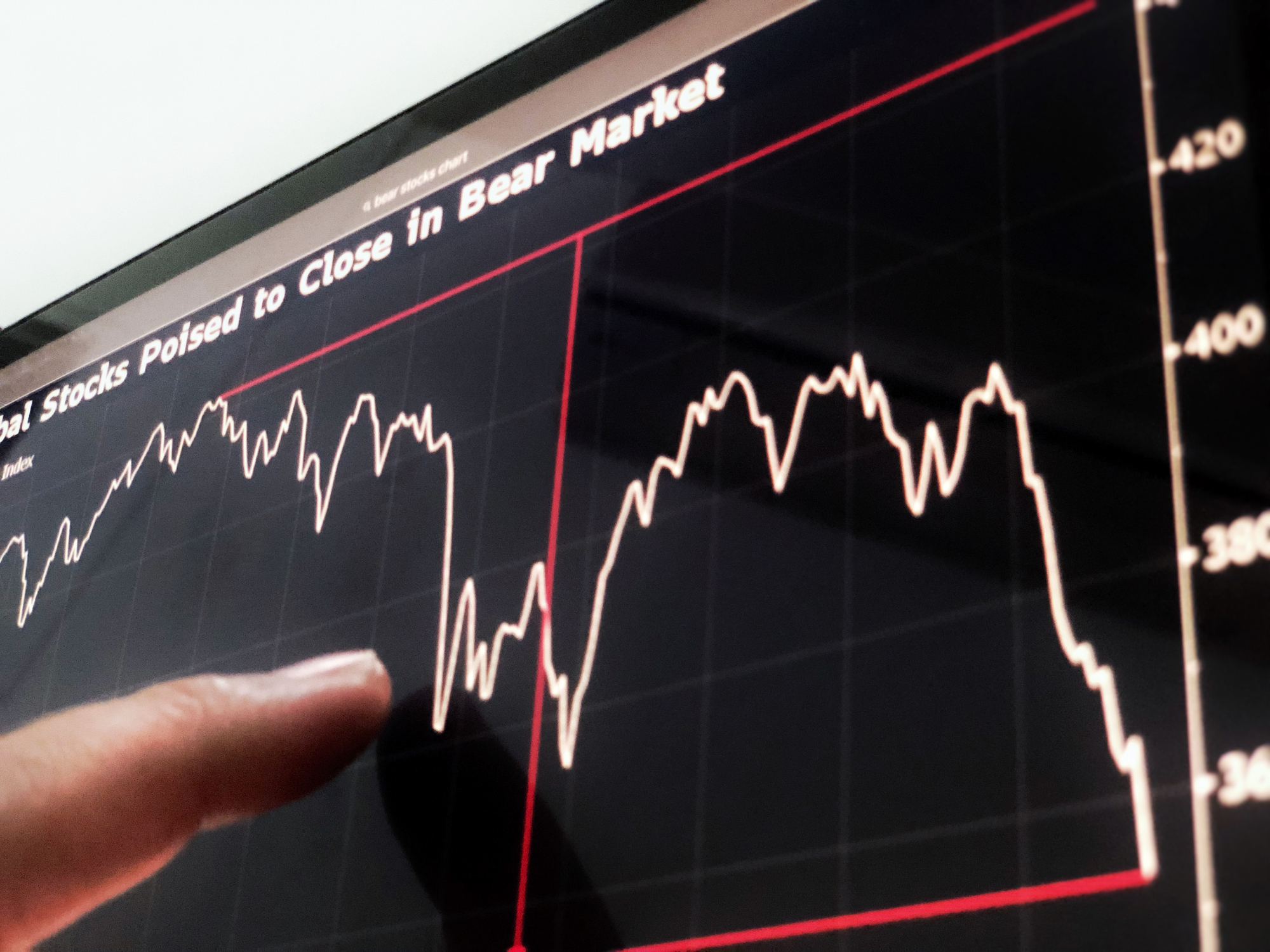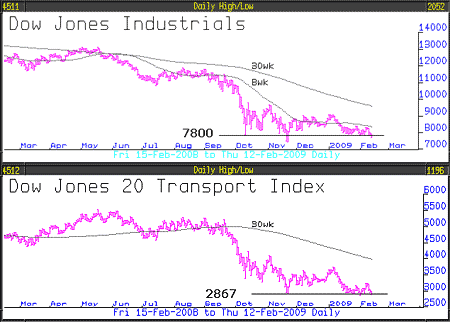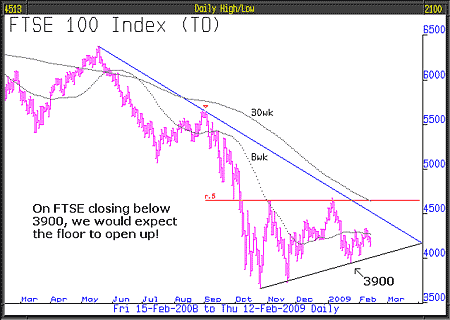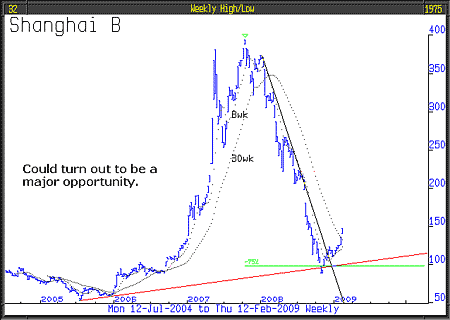The three phases of a bear market
Many people think stock markets may have hit a bottom. That's unlikely. There are three distinct phases in a bear market - and we're still only at phase two.

It is now an accepted fact that we are in a primary bear market of historic proportions; however, there is a strong consensus that although the economic outlook remains appalling, that this bear market may have bottomed out. We would regard that as a possibility but we think it's wholly unlikely. To elucidate, below is an apt definition of a primary bear market written by Victor Sperandeo in his book
. He said, about primary bear markets:
"A primary bear market is the long downward movement interrupted by important rallies. It is caused by various economic ills and does not terminate until stock prices have thoroughly discounted the worst that is apt to occur. There are three principal phases of a bear market: the first represents the abandonment of hopes upon which stocks were purchased at inflated prices; the second reflects selling due to decreased business and earnings, and the third is caused by distress selling of sound securities, regardless of their value, by those who must find a cash market for at least a portion of their assets."
MoneyWeek
Subscribe to MoneyWeek today and get your first six magazine issues absolutely FREE

Sign up to Money Morning
Don't miss the latest investment and personal finances news, market analysis, plus money-saving tips with our free twice-daily newsletter
Don't miss the latest investment and personal finances news, market analysis, plus money-saving tips with our free twice-daily newsletter
No matter how closely we look at what's going on, we don't see any sign, as yet, of phase three given that this is the ultimate primary bear market caused by the ultimate banking crisis, we can't believe phase three will be omitted from the schedule.
We move on to two investment giants of the past, on whose shoulders we stand Charles Dow and W D Gann.
Charles Dow was largely responsible for the thinking that led to "Dow Theory". Dow Theory works on a simple principle (always the best sort). If the Industrials that represent production of goods and the Transports (originally the Railroad Index) that represent the distribution of goods are both in ascendency, the economy and stock market should perform well. A signal of uncertainty would be a diversion in the direction of these two indices. If the economy is contracting and the outlook for stock markets is very bad, they will confirm by jointly declining.
To illustrate, below is the 12-month chart for the Industrials, sitting above the 12-month chart for the Transports, they are both on the edge of a cliff. One or two more bad days could lead to a breach of the support levels which will deliver a new Dow Theory primary bear market signal. The two levels are 7800 and 2867, watch them closely and if both close below those levels, it might signal the start of the expected third and most virulent phase.

W D Gann's key tools of trade were his brilliant intellect and technical analysis skills - we strive to emulate him. He said this:
"When a stock or a commodity advances into new territory or to prices which it has not reached for months or years, it shows that the force or driving power is working in that direction. It is the same principle as any other force which has been restrained and breaks out. Water may be held back by a dam, but if it breaks through the dam, you would know that it would continue downwards until it reaches another dam or some obstruction or resistance which would stop it."
You will see the work of Charles Dow and W D Gann come together with Trader Vic's succinct primary bear market description. It is no surprise, we think, that the two worst stock market days so far this year were firstly the day of Barrack Obama's inauguration and then secondly the day his Treasury Secretary, Tim Geithner, laid out the details or, should we say, the lack of details of the proposed stimulus package.
We suspect in the leadened hearts of even the most enthusiastic stock market fans, they know that no matter how genuine their new President is that his task is more like a natural disaster that has to be suffered than a financial disruption which a deft hand of manipulation can fix.
FTSE continues in its trading range, the most recent action has been biased to the downside. Price action has remained below both the long-term 30-week moving average and the more aggressive 8-week moving average a close below 3,900 would lead to our bear note becoming an even bigger winner and such a development, especially if combined with a new bear market signal from Dow Theory, might lead to an increase in exposure to the short side of the UK stock market.

Housing Market
Very little good news from anywhere! French house prices for the fourth quarter 2008 fell 9.9%, the steepest decline since records began in the 1930s.
We consider that, for the time being, the outlook for residential and commercial property remains very poor because the economic condition is the grimmest ever.
Unemployment
US non-farm payrolls for January declined by 598,000 worse than expected and it's now the case that over the past twelve months, 3.5 million US jobs have been lost the worst number since the series began in 1939. An ominous side note is that in the 1930s, at the time of the Great Depression so far the worst economic condition in the modern world, the unemployment rate rose to 25%! The January figure is modest by comparison at 7.5%.
Consumer spending
Surprisingly, the British Retail Consortium reported that January same-store sales were 1.1% higher than January 2008, although January this year followed a much worse December than a year ago. Is it possible that young consumers, who are apparently the least affected group, can sustain on their own, the retail industry?
Corporate earnings
Companies and consumers are concerned with only one thing and that's survival. In order to survive, the natural thing to do is to retrench even though, for everybody else, that is the worst possible thing. Companies both sack staff and cancel capital expenditure to cut costs; the unemployment levels rise dramatically and the earnings of companies fall. It's an unstoppable force that has considerable momentum and is likely to continue to a 'last man standing' situation. Only the strong will survive - another good reason why the stock market is so vulnerable. In the fourth quarter 2008 corporate bank deposits fell £6.5 billion, the biggest drop since records began in 1998 and as Michael Saunders, an economist at Citibank, said "The fact that corporate liquidity is still worsening, suggests that corporate retrenchment is not even close to finished."
It's all about Obama and his plan. Sadly, it's likely to be inadequate. Lex, in the Financial Times this week, said "The Treasury remains unprepared to face the uncomfortable reality that some of banking's big beasts and best brands are insolvent."
Martin Wolf said in his 'must read' piece in Wednesday's FT entitled "Why Obama's new Tarp would fail to rescue the banks".
"If he fails to act decisively, the President risks being overwhelmed like his predecessor. The costs to the US and the world of another failed presidency do not bear contemplating."
"What is needed? The answer is: focus and ferocity. If Mr Obama does not fix the crisis, all he hopes from his presidency will be lost Hoping for the best is foolish. He should expect the worst and act accordingly."
"Yet hoping for the best is what one sees in the stimulus programme and so far as I can judge from yesterday's sketchy announcement by Tim Geithner, Treasury Secretary also in the new plans for fixing the banking system."
The sad truth is that the new President and his team will inevitably default to optimism for fear of frightening the horses.

The Chinese stock market has delivered a technical buy signal having since last year fallen 75%. The chart of the Shanghai "B" Index is above. You can see quite clearly that the down trend has been taken out and a rally has taken the price through the 30-week moving average. There is a strong possibility that a bull market for Chinese stocks, or at least a significant rally for Chinese stocks, is in its early stages.
We expect to expose portfolios to this opportunity to the tune of approximately 7.5%.
This article was written by John Robson & Andrew Selsby at Full Circle Asset Management,as published in the threesixty Newsletteron 13 February 2009.
Get the latest financial news, insights and expert analysis from our award-winning MoneyWeek team, to help you understand what really matters when it comes to your finances.
MoneyWeek is written by a team of experienced and award-winning journalists, plus expert columnists. As well as daily digital news and features, MoneyWeek also publishes a weekly magazine, covering investing and personal finance. From share tips, pensions, gold to practical investment tips - we provide a round-up to help you make money and keep it.
-
 How the Budget will hurt you: MoneyWeek Talks
How the Budget will hurt you: MoneyWeek TalksPodcast An Autumn budget podcast special episode, featuring MoneyWeek editors Kalpana Fitzpatrick, Andrew van Sickle and Cris Heaton.
-
 The new 4% rule – how much should retirees really draw from their pension in 2026?
The new 4% rule – how much should retirees really draw from their pension in 2026?Brits retiring in 2026 could be withdrawing too much from their pension pots if they stick to an old rule about ‘safe’ limits – with the risk of running out of money in retirement

